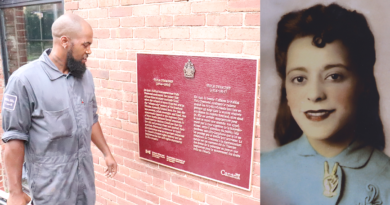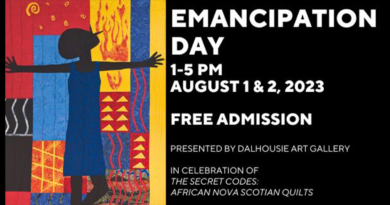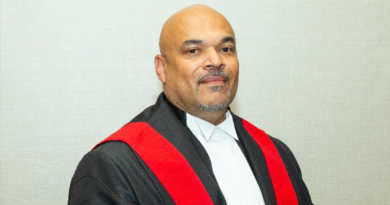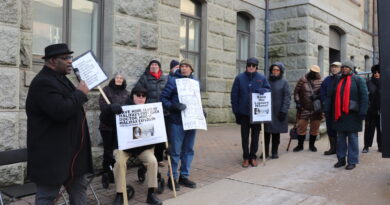The long road to Emancipation Day

It was just after 6pm this past Sunday when the Emancipation Day concert got underway at Parade Square in Halifax. A cold wind suddenly came about as the sun began to further disappear into the shade of the downtown high-rises.
Not long into the event, East Preston native and Senator Wanda Thomas Bernard took to the microphone.
“In February we marked the 25th anniversary of the national recognition of Black History Month in Canada,” she said to a round of applause.
“So, 25 years ago the Honourable Jean Augustine [the first African-Canadian woman to be elected to as a Member of Parliament] put forward a motion in the House of Commons to have February designated Black History Month. And at the same time, there were lobby efforts being made to have Emancipation Day recognized. So that’s how long this has been in the making. Over 25 years.”
Emancipation Day, August 1, marks the same day in 1834 when slavery was officially banned in all of the British colonies, including in what would eventually become Canada.
This past March, Parliament voted unanimously to officially recognize Emancipation Day. Nova Scotia did the same the following month.

Nova Scotia is a small world — even more so amongst its Black residents. There were many familiar Black faces among the crowd that evening. Though it was a Black Canadian woman from out of province who Bernard gave credit to for her efforts to have Emancipation Day officially recognized in Canada.
“Rosemary Sadlier who was president of the Ontario Black History Society at the time was certainly one of the lead people moving and trying to move forward with Emancipation Day,” Thomas Bernard said. “The province of Ontario passed legislation in … 1983, I think. So, they’ve been celebrating (and) marking Emancipation Day in Ontario for a number of years.”
Rosemary Sadlier spoke to the Examiner this week about her former role as president and unofficial executive director of the Ontario Black History Society, her role in getting Black History Month and Emancipation Day recognized by the government, Britain’s original Slave Emancipation Act, and some of the lesser-known consequences it had on Black people in North America at the time.
In 1993, Sadlier said she “unexpectedly” became president of the Ontario Black History Society where she was already a board member. The role of president was a volunteer position. Most of her work was done from home. She was still nursing her third-born child at the time of the appointment.
The other board members were a generation older than her and were either unable, unwilling, or lacked the confidence to fully participate in many of the society’s community engagement initiatives.
“So that meant that anytime they, as the board … would make a decision about what we should do going forward, it was on me to carry it out,” Sadlier said. “Not because I wanted it to be that way, it’s just the way it was.”
“And we couldn’t afford to pay an executive director. So, at certain points in time, I was the president, and essentially the executive director, too.”
Sadlier said she soon found herself in a panic situation when a clerical error put the upcoming annual Black History Month proclamation by the city of Toronto in jeopardy. Though new to her position, Sadlier says she was able to scramble and prevent that from happening.
“I then secured… a better proclamation that was going to be issued annually. I also went to the province and got one with the province and went to the federal government. All the while building up a community of interest through having more events, doing more presentations in schools and community groups, and so on.”
Sadlier said she then pursued efforts to have Black History month recognized all across Canada.
“So, by the time I went to the federal government, and I approached … Black parliamentarians and Black senators, it ultimately fell to Jean Augustine, and she did take it to the house and thus formalized the celebration.”
“I was the person providing her office with Black history information. Constantly, you know. And I was the only person that ended up on stage — the only non-elected person on stage — for the first national celebration as February as Black History Month.”
Later that year, in October of 1995, Sadlier said she connected with a member of the Caribbean Historical Society of Trinidad and Tobago, and they “began a process of formalizing August 1 as Emancipation Day.”
“And by October of 1996, I had been able to secure proclamation with the city of Toronto, with Metro Toronto — we still had Metro Toronto, and with the city of Ottawa,” she said.
“Then, knowing how hard it had been to get a proclamation of Black History Month from every province, I thought ‘Well, why not just go to the federal level as soon as I can, and then (Emancipation Day) will still be effective in every province.’”
Sadlier said she then took a non-partisan approach when reaching out to various politicians in Ottawa. She said the leader of the former Reform Party, Preston Manning, was very receptive to the idea.
Eventually, Tanzanian-born Calgary East MP, Deepak Obhrai, ended up putting forth two members bills in 1999 and 2000. Neither one went through.
Though, in 2008, three members of the Ontario legislature put forth an all-party bill, to have Emancipation Day recognized provincially in Ontario. It passed unanimously.
“So, this was great! We were having combined, all-party celebrations of Emancipation Day.”
“I also should add that I was the first speaker at the resurgence of Emancipation Day in Windsor, and I spoke instead of the US Consul General, John Nay, because he asked me to do so. He felt that the honour and the privilege should be mine.”
After leaving the Ontario Black History Society in 2015, Sadlier said she continued to meet with her local MP and other people in Ottawa to try to get Emancipation Day federally recognized. This was around the time Wanda Thomas Bernard was appointed to the Senate.
“And then there was a change,” Sadlier said. “Senator Wanda Thomas Bernard thought that she could get it through the Senate.”
After another failed attempt in 2018 and following the worldwide Black Lives Matter movement in 2020, on March 24, 2021, the House of Commons unanimously voted in favour to federally recognize Emancipation Day.
Haitian Revolution ‘tipped the scales for everybody’
Sadlier said that the largest annual celebration of Emancipation Day in all of North America took place in Windsor, Ont. and dates back to 1834 when the British proclamation was first enacted. Emancipation Day in that city was celebrated each year for decades.
“They had thousands of people. It was huge! They had Motown. They had Eleanor Roosevelt. I mean that was a celebration,” Sadlier said.
“It ended in the 1960s because there were concerns that the civil rights movement would spill over into Canada and some of the protests might become violent. That was the concern of certain people in government. So, it was actually ended by government and the police in the 1960s.”
As for the initial proclamation itself, Sadlier said African resistance to slavery was the catalyst that made it possible in the first place.
“Emancipation comes about because of two things: because there was slavery, and because there was resistance to slavery. And it’s that resistance to slavery that put people in a position — people who had power, people who owned slaves, people who owned hundreds of slaves — in a position where they had to start to think about what they could do to ensure that either there was an easy transition from slavery to a semblance of freedom, or know that they would lose everything that they had.”
In particular, Sadlier points to the Haitian Revolution:
“With the formation of this significant Black-led, Black-controlled state in the Caribbean, people who had slave interest in nearby islands, particularly in Jamaica or Barbados, or even British South America, people who had thousands of slaves now knew that they could be looking at the same kind of issue.”
“That, to me, is the one that tipped the scales for everybody … Not that there weren’t things that were happening in the United States … There were absolutely slave revolts going on there. Absolutely slave revolts going on in Jamaica, in Barbados, in Guiana, in Bermuda, in Canada. But this one — this one was huge! Huge! And it had to have been the subject of discussion everywhere across all the slave-owning powers in Europe: ‘What are we gonna do? How are we going to manage? What is the best next step?’”
Sadlier said that years earlier, in 1793, a British “compromise legislation” had a “mild effect” that helped bring many of the Black Loyalists to Nova Scotia and New Brunswick.
“But it didn’t end slavery for Africans in this country,” she said.
Though when it came to slavery in Canada, Sadlier said there were stark contrasts to how it operated in the United States.
“Because in Canada there were already challenges … Not because we were nicer — although that’s certainly what we may have been taught in a way — but because it was just more expensive,” Saidler said. ”
“We have long winters. Even in southern Ontario, we still have winter. And you have to feed people if you want them to survive. You have to keep them warm. That’s a lot of fuel and food that you have to find a way to store up and make available to those people. Whereas in the southern states, or in the Caribbean, there was an abundance that might be available year-round that slave owners didn’t have to quite worry about in the same way.”
“It’s about the climate, it’s about fear, it’s about cost, it’s about many things.”
Nevertheless, Sadlier said that the British proclamation of Emancipation still had an immediate impact south of the Canadian border in the US where slavery wouldn’t be banned for almost another 30 years.
“It meant that automatically there were all kinds of Black people who made their way to Canada on the Underground Railroad.”
“They poured into the country minutes after the British Imperial Act went into effect here. And if they couldn’t get to Canada by walking — that was usually the easiest way — they also considered going into British-controlled areas in the Caribbean and Bermuda.”
“So that also, I believe, lead to this version of Canada as a place of freedom they’ll tend to focus on, and in a particular sense, it’s true because the law indicated that enslaved Africans would no longer be slaves in this territory. But it doesn’t speak to the reality that full equity was not made possible. It doesn’t speak to the reality that there were pointed efforts made through all of our systems to prevent, or subdue, or close access to things that other people could take for granted.”
With the Underground Railroad now in full swing, this led to unforeseen consequences for Black people in Canada that many people don’t associate with, or even recognize, as being directly attributable to the British Emancipation Act.
Wanted signs for escaped slaves started popping up. This created a boom in illegal cross-border bounty hunting. Bounty hunters would enter Canada in pursuit of not only formerly enslaved Black people from the US, but also random Black people to be illegally sold into slavery back in the US.
“Actually, some of the wanted ads that we still, up until very recent times, had in our hard-copy newspapers, they all track directly back to ads that people were posting looking for their enslaved Africans. That’s what many of the “wanted” ads were about.”
“Sometimes there was a definite description and a name and a location, and they would come looking for specific people who may have just left, or who were favourites, or who were valuable because of whatever skills they had. But sometimes, yes, there were people who would just cross the border.”
Sadlier said that tactics used to push back against this sort of thing were similar to some law enforcement tactics we see nowadays.
“And so, places like Windsor-Detroit, Niagara Falls US and Canada, and some of the other areas like Amherstburg and Fort Malden, that area … those really had to be carefully guarded. There were always people — Black people — watching for… Kinda like today, people who are aware might be watching for human traffickers, for, you know, men with young girls who seem to be acting in a suspicious way … There would be comparable things where people would be watching for maybe white men trying to entice or actually (succeed) in capturing younger and, in particular, Black people who they fully intended to take to the United States.”
‘It’s only gonna get bigger and better from here’
“So, it’s official. Emancipation Day has been marked from coast to coast to coast,” Senator Thomas Bernard said to a round of applause as she continued her remarks in Halifax on Sunday. “Coast to coast to coast we’ve seen celebrations like this one.”
Before closing, she went on to talk about the future and ongoing efforts to receive an official apology from the federal government.
“Black Canadians have never received an official apology… For the atrocities, the violence, the enslavement of African people.”
One person in the audience shouted out “Reparations!” which she acknowledged but added that “reparations come in many different forms, some people think of reparations as only about money.”
The Senator’s remarks were followed by musical performances by a local African drumming ensemble, and local artists Zamani, Kye Clayton, MAJE, and Colours of Africa.
There were remarks made by Sackville High School valedictorian Akwaima Akpan, as well as a spoken word performance by Asiah Sparks.
Gary “Papa Grand” James took to the mic before his unscheduled performance and awarded his nephew, Trayvon Clayton, who co-hosted the event along with DeRico Symonds and Kate Macdonald, with a replica LeBron James championship Lakers ring and thanked him for all of his work in the community.

Trans activist, Chris Cochrane, also known as Elle Noir, then performed a lip-sync and dance. The Nova Scotia Mass Choir took to the stage to close the show.
Educator Bernadette Hamilton Reid who often live-streams Black community events throughout the province was in attendance. When asked for comment at the end of the night she said, “I think it was a great time for celebration, for us to come together, it was beautiful, long overdue, but you know it’s only gonna get bigger and better from here. We definitely have a message to share.”
In addition to Halifax, there were a number of other Emancipation Day ceremonies Sunday that took place across the province in places like Guysborough County, Truro, and Yarmouth, as did a province-wide virtual walk/run. There are a number of additional upcoming ceremonies and events taking place this month, including a church service and barbecue at the Afrocentric Park in New Glasgow this Sunday.








